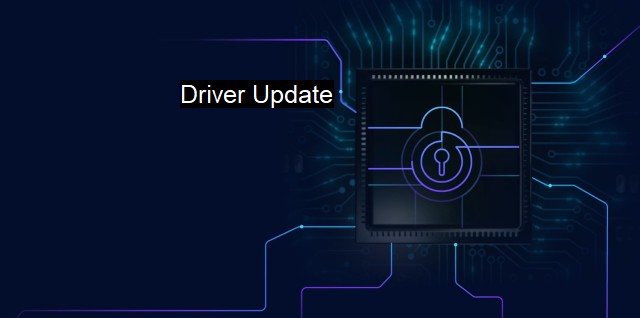What is Driver Update?
The Significance of Driver Updates in Ensuring Cybersecurity and Antivirus Solutions: Understanding the Challenges and Benefits.
A driver update is a critical computer process that entails updating one or several drivers in a PC system to optimize performance and boost functionality. Drivers are software elements that allow the operating system (OS) and other software programs to interact with the hardware components of a computer system. They essentially act as interpreters taking instructions from the software and translating them into functions executable by the hardware.For instance, the printer drivers interpret the printer software's commands into the format that the printer hardware recognizes. Similarly, the drivers for graphics cards take the operating system or game software's commands, translating them into instructions that the respective graphics card understands. The beauty of drivers is that they essentially insulate the OS and software applications from the specifics of the hardware, allowing these software programs to operate virtually across any system without extensive customization.
Just like any other software component, the drivers should be regularly updated to maintain peak system performance. Updating the drivers often helps in fixing known bugs, closing security loopholes, dealing with compatibility issues, and implementing new features designed by the manufacturer for better functionality of the respective hardware.
Updating drivers essentially fortify cybersecurity of a computer. In today’s world, cyber threats are prevalent. Cybercriminals exploit various vulnerabilities in computer systems to infiltrate the systems and do harm. One of the susceptibilities in the security chain that is often under-exploited is outdated drivers. Outdated drivers carry vulnerabilities that malware can potentially exploit. Updating the drivers, therefore, ensures these loopholes are sealed, enhancing the protection of the bigger system.
Often, manufacturers release newer versions of drivers to patch, known security holes that hackers may exploit. An example is Eternal Blue, a vulnerability amongst some versions of the Microsoft Windows OS that was exploited by the WannaCry Ransomware attack in 2017. By continually updating your drivers, you ensure you install the latest patches, effectively nullifying such loopholes.
Outdated driver versions also lead to compatibility issues with newly updated or installed software. Such scenarios often result in abrupt systems shutting down or freezing. Such dysfunctions can present an additional pathway for malicious software.
Another way that driver updates contribute to cybersecurity involves antivirus software. Modern-day antivirus programs are not merely basic defenders against known malware but rather provide comprehensive fortification against a range of cyber threats. They include various elements such as firewalls, VPNs, parental controls, and password managers, among others. Antivirus software is continually updated to keep up with the ever-evolving cyber threats.
The antivirus software itself requires certain drivers to work correctly. Outdated drivers imply that the antivirus might not function as expected or even fail altogether. Updating the drivers, therefore, ensures the optimal functioning of the antivirus software, effectively fortifying the overall system security.
Driver updates are vital for both the functionality and cybersecurity of a computer system. Updating the drivers can plug security loopholes, fix bugs, and improve overall performance. periodically updating these drivers ensures removal of outdated or weak links in the system that can be exploited, maximizing the antivirus software potential, ultimately leading to a substantially more secure computer system. Continuous updating of drivers becomes even more critical with the increasing cyber threats in modern computing environments.

Driver Update FAQs
What is a driver update and why is it necessary for cybersecurity and antivirus?
A driver update is a software update that enhances the performance of a computer's hardware, firmware or software components. It's necessary for cybersecurity and antivirus because outdated drivers can create vulnerabilities and security issues that hackers can exploit. Updating drivers ensures that software is more secure and protected from potential threats.How can I check if my drivers are up-to-date?
You can check if your drivers are up-to-date by going to the device manager on your computer. Once you're on the device manager, locate the device you want to check and right-click on it. Select "Properties" and then select the "Driver" tab. Here, you'll see the driver version and the date it was last updated. If it's been a while since the last update, you may need to install a newer version.What are the risks of not updating drivers?
The risks of not updating drivers include decreased performance, compatibility issues, and security vulnerabilities. If drivers are not updated, they can become outdated and may not work correctly with newer software. This can cause compatibility issues and may result in errors or crashes. Outdated drivers can also leave your computer open to security vulnerabilities that can be exploited by hackers.How often should I update my drivers?
How often you should update your drivers depends on your computer usage and the types of software you use. As a general rule, it's a good idea to check for updates at least once a month. However, if you use your computer frequently and run resource-intensive applications like games or video editing software, you may need to update your drivers more frequently. If you're unsure about whether you need to update your drivers, you can set your computer to perform automatic updates or consult with a cybersecurity professional.| | A | | | B | | | C | | | D | | | E | | | F | | | G | | | H | | | I | | | J | | | K | | | L | | | M | |
| | N | | | O | | | P | | | Q | | | R | | | S | | | T | | | U | | | V | | | W | | | X | | | Y | | | Z | |
| | 1 | | | 2 | | | 3 | | | 4 | | | 7 | | | 8 | | |||||||